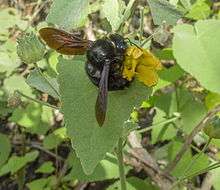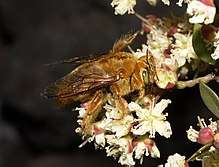Xylocopa darwini
Xylocopa darwini, the Galápagos carpenter bee, is one of only three species of bees found in the Galápagos Islands, to which it is endemic.[2][3] This species is sexually dimorphic, is found on 75% of the largest islands, and is known for its complex behavior. As the only native bee, Xylocopa darwini serves as an important primary pollinator within the plant-pollinator network of the archipelago.
| Galápagos carpenter bee | |
|---|---|
 | |
| Female, on Bastardia viscosa (viscid mallow), Santa Cruz Island | |
| Scientific classification | |
| Kingdom: | Animalia |
| Phylum: | Arthropoda |
| Class: | Insecta |
| Order: | Hymenoptera |
| Family: | Apidae |
| Genus: | Xylocopa |
| Species: | X. darwini |
| Binomial name | |
| Xylocopa darwini Cockerell, 1926[1] | |


Description
The leaf-cutter bee and the wool carder bee are introduced, making the Galápagos carpenter bee the only native species.[4] As a sexually dimorphic species, the male and female bees look different. The female bee is dark and shiny with black setae, and is commonly found throughout the year. The male is rarer, with a black abdomen and yellow-brown setae.[5] A rare specimen in the Smithsonian collection exhibits gynandromorphism, with a visually female left side and a visually male right side.[6]
Distribution
Galapagos carpenter bees can be found on 9 out of the 12 largest islands, but not all of the islands in the archipelago. These include Isabela, San Cristóbal, Santa Cruz, Santiago, Fernandina, Floreana, Genovesa, Santa Fe, and Española.[7] These bees are parasitized by the blister beetle Cissites maculata, and the two species have a phoretic relationship. The presence of both the bees and parasitoid beetles on the islands suggests that they were transported together and colonized the archipelago concurrently.[8][9]
Behavior
This insect gets its common name 'carpenter bee' from the way that females form nests. They bore holes into the branches and trunks of trees and lay their eggs within the solitary cavities.[10][11] They prefer to bore holes into soft dead wood, such as the wood of sea hibiscus, Croton, palo santo and coral trees.[12] Male Galápagos carpenter bees have been recorded exhibiting territorial behavior, and may defend plants from intruders. They patrol the claimed shrub or tree and chase away trespassing animals, but allow female bees to enter the defended area.[13]
Ecological role
These insects serve as an important keystone species since they are the predominant pollinators of native and introduced plants on the islands.[14][15][16] They are the most generalized pollinators in the Galápagos ecosystem, meaning that they consume nectar and pollen from the widest array of different flowers, adding up to at least 84 flowering species.[14][16] They compete for food with other pollinators including birds, lizards, and other insects.[14] Their niche as pollinators is vital to the stability of plant populations, even though most well documented plant species on the archipelago are capable of self-pollination.[14] Galapagos carpenter bee populations could be negatively impacted by invasive species through competition and predation. Introduced birds such as the Smooth-billed ani have been documented preying on the bees, which ecologists say could significantly affect the unique ecosystem of the archipelago.[17]
References
- "ITIS Standard Report Page: Xylocopa darwini". Integrated Taxonomic Information System (ITIS). Retrieved 2015-06-19.
- Nicholls, Henry (2014). The Galápagos : A Natural History. New York: Basic Books. pp. 62–63. ISBN 978-0-465-03597-7.
- "Xylocopa darwini". Galapagos Species Checklist. Charles Darwin Foundation. Retrieved 2015-06-19.
- Author), Claus Rasmussen (corresponding; Carríon, Ana L.; Castro-Urgal, Rocío; Chamorro, Susana; Gonzalez, Victor H.; Griswold, Terry L.; Herrera, Henri W.; McMullen, Conley K.; Olesen, Jens M.; Traveset, Anna (July 2012). "Megachile timberlakei Cockerell (Hymenoptera: Megachilidae): Yet another adventive bee species to the Galápagos Archipelago". The Pan-Pacific Entomologist. 88 (1): 98–102. doi:10.3956/2012-04.1. ISSN 0031-0603.
- Bowman, Robert I., ed. (1966). The Galápagos: Proceedings of the Symposia of the Galápagos International Scientific Project. Berkeley: University of California Press. p. 64. OCLC 752923272. Retrieved 2015-06-19.
- Zama, Paula Caetano; Coelho, Igor Rismo (13 June 2017). "New Cases of Gynandromorphism in Xylocopa Latreille, 1802 (Hymenoptera: Apidae)". Papéis Avulsos de Zoologia. 57 (24): 313–319. doi:10.11606/0031-1049.2017.57.24. ISSN 1807-0205.
- Vargas, Pablo; Rumeu, Beatriz; Heleno, Ruben H.; Traveset, Anna; Nogales, Manuel (25 March 2015). "Historical Isolation of the Galápagos Carpenter Bee (Xylocopa darwini) despite Strong Flight Capability and Ecological Amplitude". PLOS ONE. 10 (3): e0120597. doi:10.1371/journal.pone.0120597. ISSN 1932-6203. PMC 4373804. PMID 25807496.
- Vargas, Pablo; Rumeu, Beatriz; Heleno, Ruben H.; Traveset, Anna; Nogales, Manuel (25 March 2015). "Historical Isolation of the Galápagos Carpenter Bee (Xylocopa darwini) despite Strong Flight Capability and Ecological Amplitude". PLOS ONE. 10 (3): e0120597. doi:10.1371/journal.pone.0120597. ISSN 1932-6203. PMC 4373804. PMID 25807496.
- Hurd, Paul D. (October 1958). "The Carpenter Bees of the Eastern Pacific Oceanic Islands (Hymenoptera: Apoidea)". Journal of the Kansas Entomological Society. 31 (4): 249–251. JSTOR 25083084.
- Vargas, Pablo; Rumeu, Beatriz; Heleno, Ruben H.; Traveset, Anna; Nogales, Manuel (25 March 2015). "Historical Isolation of the Galápagos Carpenter Bee (Xylocopa darwini) despite Strong Flight Capability and Ecological Amplitude". PLOS ONE. 10 (3): e0120597. doi:10.1371/journal.pone.0120597. ISSN 1932-6203. PMC 4373804. PMID 25807496.
- "Galapagos carpenter bee". Galapagos Conservation Trust. Retrieved 2020-04-05.
- Hurd, Paul D. (October 1958). "The Carpenter Bees of the Eastern Pacific Oceanic Islands (Hymenoptera: Apoidea)". Journal of the Kansas Entomological Society. 31 (4): 249–251. JSTOR 25083084.
- Linsley, E.G. (1965). "Notes on male territorial behavior in the Galapagos carpenter bee". The Pan-Pacific Entomologist. 41: 158–161 – via Biodiversity Heritage Library.
- Chamorro, Susana; Heleno, Ruben; Olesen, Jens M.; McMullen, Conley K.; Traveset, Anna (1 November 2012). "Pollination patterns and plant breeding systems in the Galápagos: a review". Annals of Botany. 110 (7): 1489–1501. doi:10.1093/aob/mcs132. ISSN 0305-7364. PMID 22691541.
- Philipp, Marianne; Böcher, Jens; Siegismund, Hans R.; Nielsen, Lene R. (2006). "Structure of a plant-pollinator network on a pahoehoe lava desert of the Galápagos Islands". Ecography. 29 (4): 531–540. doi:10.1111/j.0906-7590.2006.04546.x. ISSN 1600-0587.
- Schluter, Dolph (1 January 1986). "Character Displacement between Distantly Related Taxa? Finches and Bees in the Galapagos". The American Naturalist. 127 (1): 95–102. doi:10.1086/284470. ISSN 0003-0147.
- Cisneros-Heredia, D. F. (February 2018). "The Hitchhiker Wave: Non-native Small Terrestrial Vertebrates in the Galapagos". In Torres, María de Lourdes; Mena, Carlos F. (eds.). Understanding invasive species in the Galapagos Islands : from the molecular to the landscape. Cham, Switzerland: Springer International Publishing. ISBN 978-3-319-67177-2. OCLC 1023575330.
Further reading
- Vargas, Pablo; Rumeu, Beatriz; Heleno, Ruben H.; Traveset, Anna & Nogales, Manuel (25 March 2015), "Historical Isolation of the Galápagos Carpenter Bee (Xylocopa darwini) despite Strong Flight Capability and Ecological Amplitude", PLOS ONE, 10 (3): e0120597, Bibcode:2015PLoSO..1020597V, doi:10.1371/journal.pone.0120597, PMC 4373804, PMID 25807496